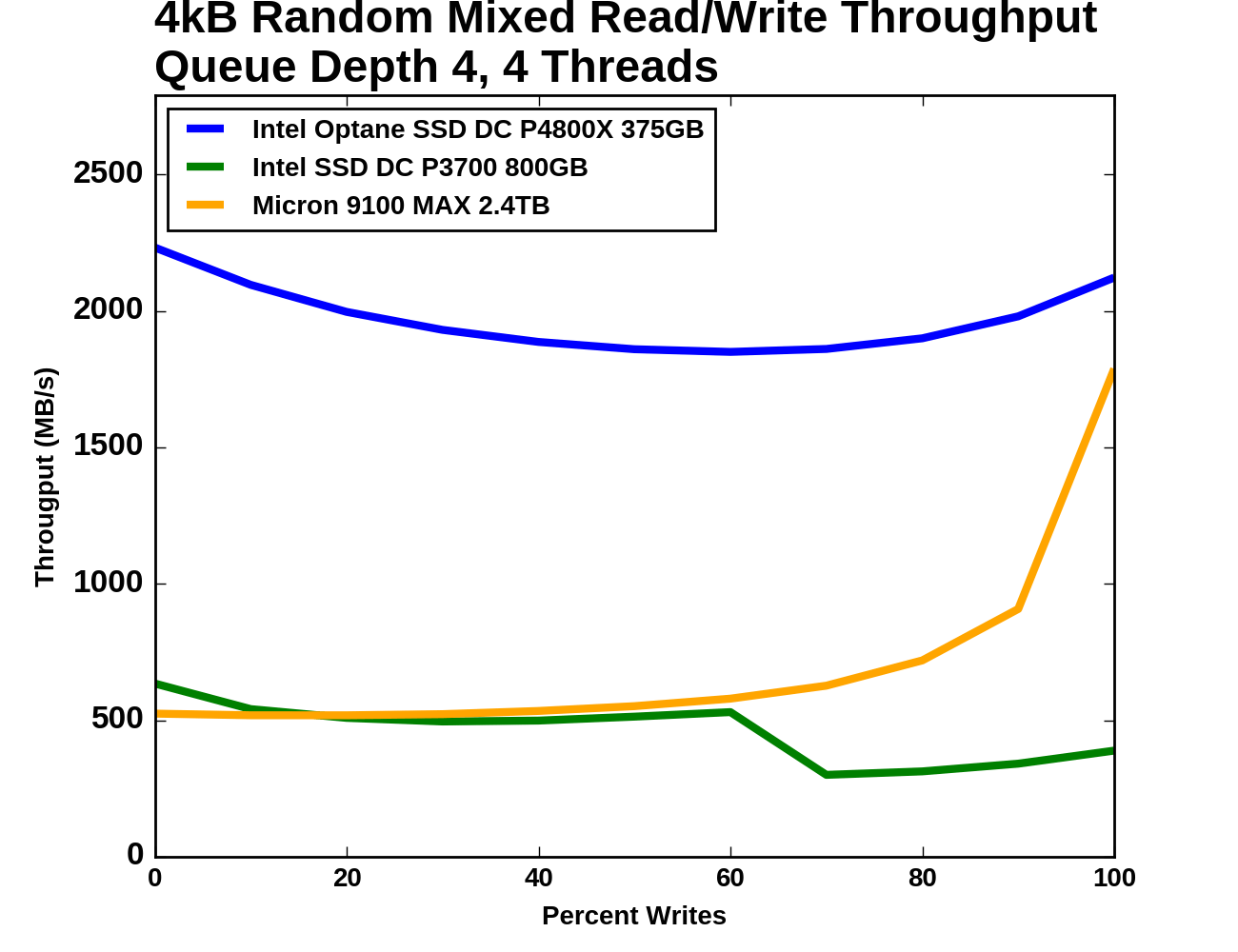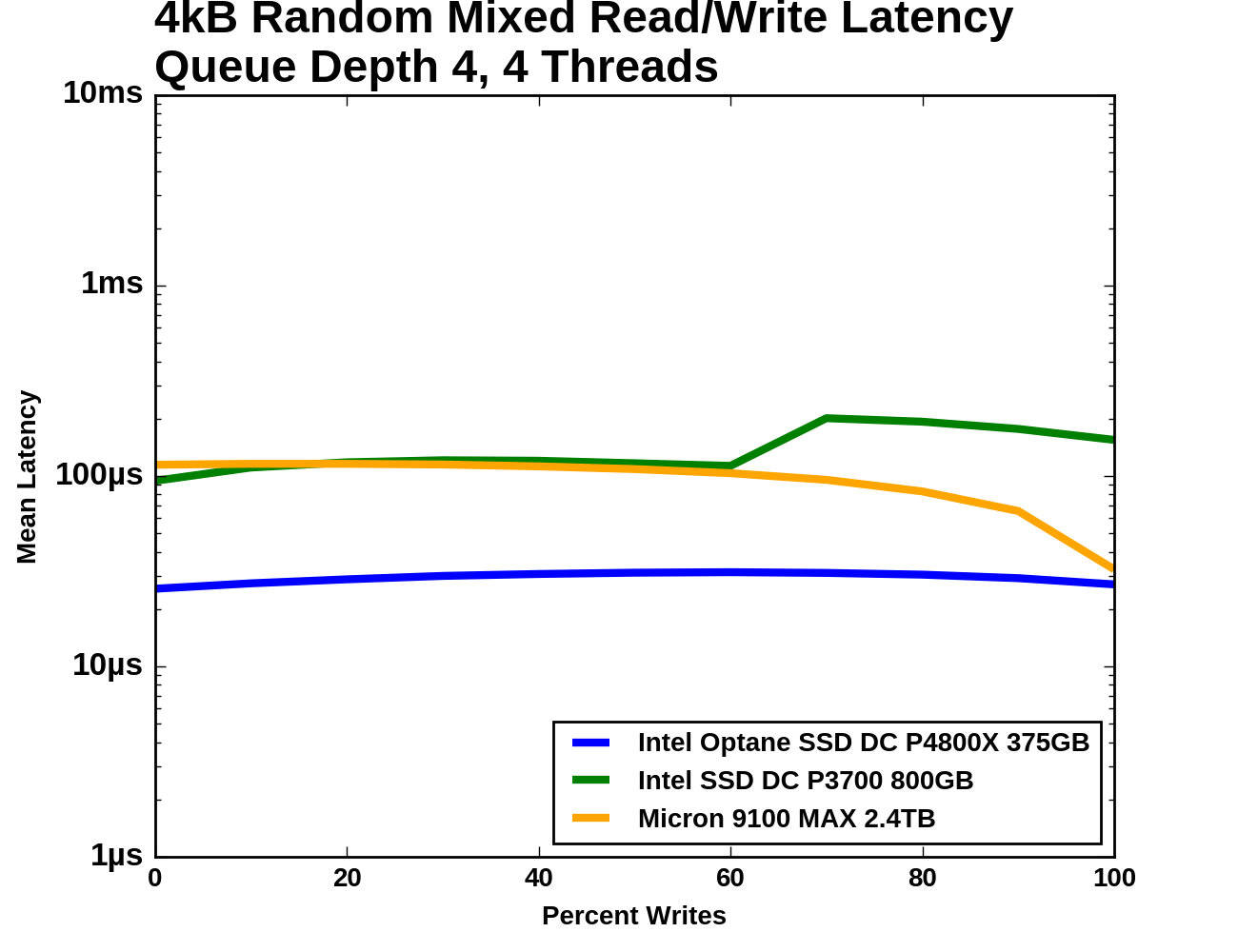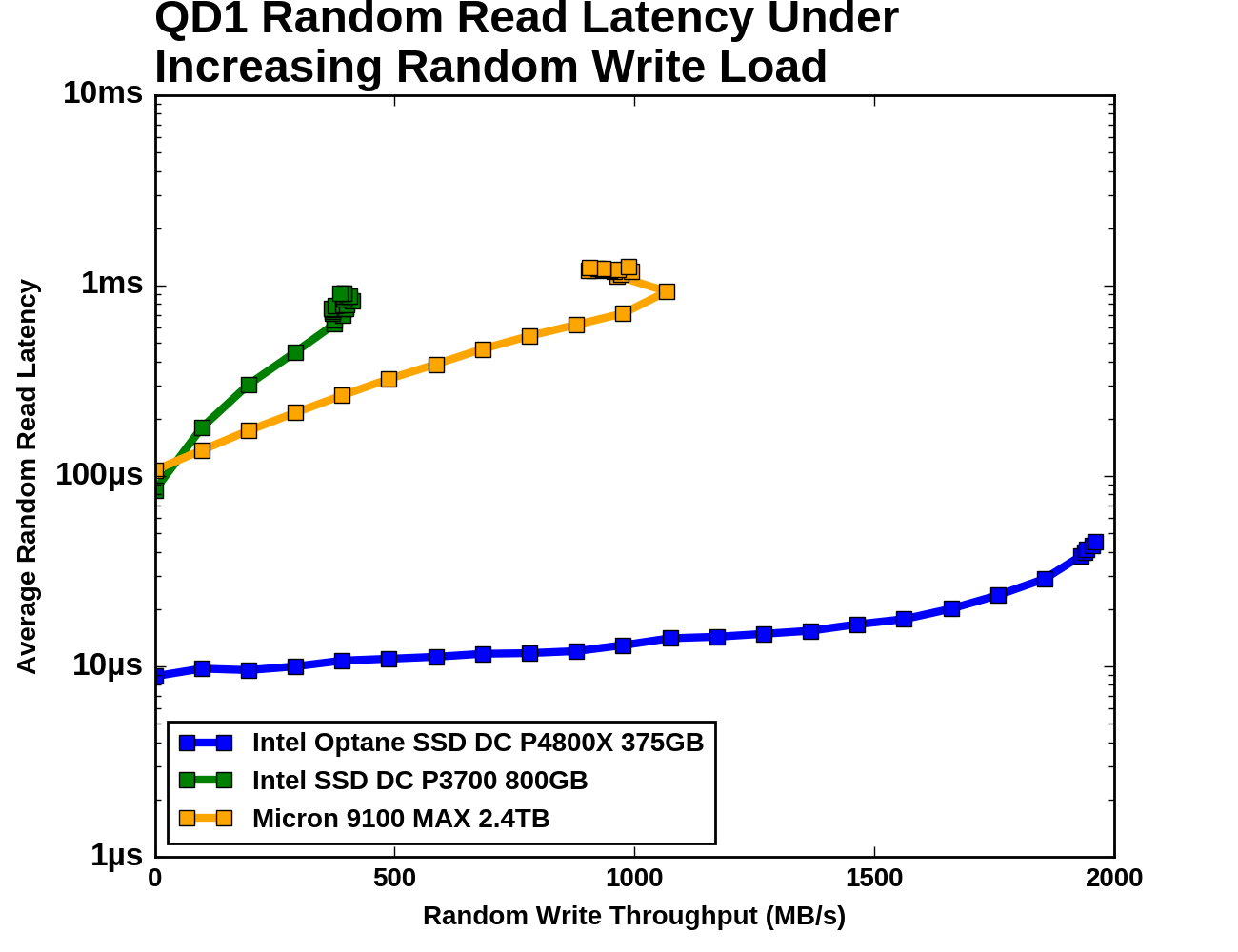The Intel Optane SSD DC P4800X (375GB) Review: Testing 3D XPoint Performance
by Billy Tallis on April 20, 2017 12:00 PM ESTMixed Read/Write Performance
Workloads consisting of a mix of reads and writes can be particularly challenging for flash based SSDs. When a write operation interrupts a string of reads, it will block access to at least one flash chip for a period of time that is substantially longer than a read operation takes. This hurts the latency of any read operations that were waiting on that chip, and with enough write operations throughput can be severely impacted. If the write command triggers an erase operation on one or more flash chips, the traffic jam is many times worse.
The occasional read interrupting a string of write commands doesn't necessarily cause much of a backlog, because writes are usually buffered by the controller anyways. But depending on how much unwritten data the controller is willing to buffer and for how long, a burst of reads could force the drive to begin flushing outstanding writes before they've all been coalesced into optimal sized writes.
The effect of a read still applies to the Optane SSD's 3D XPoint memory, but with greatly reduced severity. Whether a block of reads coming in has an effect depends on how the Optane SSD's controller manages the 3D XPoint memory.
Queue Depth 4
Our first mixed workload test is an extension of what Intel describes in their specifications for throughput of mixed workloads. A total queue depth of 16 is achieved using four worker threads, each performing a mix of random reads and random writes. Instead of just testing a 70% read mixture, the full range from pure reads to pure writes is tested at 10% increments.
 |
|||||||||
| Vertical Axis units: | IOPS | MB/s | |||||||
The Optane SSD's throughput does indeed show the bathtub curve shape that is common for this sort of mixed workload test, but the sides are quite shallow and the minimum (at 40% reads/60% writes) is still 83% of the peak throughput (which occurs with the all-reads workload). While the Optane SSD is operating near 2GB/s the flash SSDs spend most of the test only slightly above 500MB/s. When the portion of writes increases to 70%, the two flash SSDs begin to diverge: the Intel P3700 loses almost half its throughput and only recovers a little of it during the remainder of the test, while the Micron 9100 begins to accelerate and comes much closer to the Optane SSD's level of performance.
 |
|||||||||
| Mean | Median | 99th Percentile | 99.999th Percentile | ||||||
The median latency curves for the two flash SSDs show a substantial drop when the median operation switches from a read to a cacheable write. The P3700's median latency even briefly drops below that of the Optane SSD, but then the Optane SSD is handling several times the throughput. The 99th and 99.999th percentile latencies for the Optane SSD are relatively flat after jumping a bit when writes are first introduced to the mix. The flash SSDs have far higher 99th and 99.999th percentile latencies through the middle of the test, but much fewer outliers during the pure read and pure write phases.
Adding Writes to a Drive that is Reading
The next mixed workload test takes a different approach and is loosely based on the Aerospike Certification Tool. The read workload is constant throughout the test: a single thread performing 4kB random reads at QD1. Threads performing 4kB random writes at QD1 and throttled to 100MB/s are added to the mix until the drive's throughput is saturated. As the write workload gets heavier, the random read throughput will drop and the read latency will increase.
The three SSDs have very different capacity for random write throughput: the Intel P3700 tops out around 400MB/s, the Micron 9100 can sustain 1GB/s, and the Intel Optane SSD DC P4800X can sustain almost 2GB/s. The Optane SSD's average read latency increases by a factor of 5, but that still enough to provide about 25k read IOPS. The flash SSDs both experience read latency growing by an order of magnitude as write throughput approaches saturation. Even though the Intel P3700 has a much lower capacity for random writes, it provides slightly lower random read latency at its saturation point than the Micron 9100. When comparing the two flash SSDs with the same write load, the Micron 9100 provides far more random read throughput.











117 Comments
View All Comments
haukionkannel - Friday, April 21, 2017 - link
I agree. A very good product!ddriver - Friday, April 21, 2017 - link
Hypetane is based on very mature technology, only the storage medium is allegedly new. And it has gone through at least 3 refinements since first taped out.Which explains why gen1 is so "good" and also that gen2 will be barely incremental, because there is nothing much to improve upon, the only performance increase can come from more parallelism (which can be implemented with gen1 tech just as well) or improved controller.
mtroute - Friday, April 21, 2017 - link
First, wrong, just completely wrong. Second, cite your source.tuxRoller - Friday, April 21, 2017 - link
What's better?Who has better cpus?
tat tvam asi - Monday, April 24, 2017 - link
You contribute nothing to this discussion, Chaitanya. Just bileDanNeely - Thursday, April 20, 2017 - link
I'm impressed. If money is no object it's a flash killer. Unfortunately it's also way more expensive than I can afford even if I wouldn't need a new CPU/Mobo/Ram to use it. I'm really interested in seeing if the consumer focused little optane cache drives can actually make a significant difference in real world use. Tiny cache SSDs looked decent in benchmarks, but real world use patterns were sufficiently random to undermine them unless you were up to a "real SSD sized" cache of 120ish MB vs the 16/32GB of the cheap cache drives. And 120SSD + HDD was pricey enough and niche enough at the time that outside of Apple AFAIK no OEM offered it as a pre-build cache setup; and the enthusiasts who were willing to pay the price premium (myself among them) were able to just configure out boxes to keep music/images/video on the HDD and use the SSD for almost everything else.ddriver - Friday, April 21, 2017 - link
Money IS NO object. It is an abstract concept. Paper bills are only symbolic representation of money, 99% of the money don't even exist in paper form, they are just some imaginary numbers.Leosch - Sunday, April 23, 2017 - link
Aren't you a clever one. Seriously you make some good points in other comments and you are technically right in this one as well, but goddamn you're such an ass.ddriver - Sunday, April 23, 2017 - link
It is impossible to be smart and considered not an ass in a world, swarming with dummies. I'd rather be an ass than dumb. Playing dumb is not an option, because it eventually gets you. Fitting in with the dummies is not really worth it.Leosch - Thursday, April 27, 2017 - link
It is possible, you are just unable, because you're not as great as you think